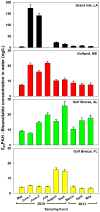Impact of the deepwater horizon oil spill on bioavailable polycyclic aromatic hydrocarbons in Gulf of Mexico coastal waters
- PMID: 22321043
- PMCID: PMC3471659
- DOI: 10.1021/es202942q
Impact of the deepwater horizon oil spill on bioavailable polycyclic aromatic hydrocarbons in Gulf of Mexico coastal waters
Abstract
An estimated 4.1 million barrels of oil and 2.1 million gallons of dispersants were released into the Gulf of Mexico during the Deepwater Horizon oil spill. There is a continued need for information about the impacts and long-term effects of the disaster on the Gulf of Mexico. The objectives of this study were to assess bioavailable polycyclic aromatic hydrocarbons (PAHs) in the coastal waters of four Gulf Coast states that were impacted by the spill. For over a year, beginning in May 2010, passive sampling devices were used to monitor the bioavailable concentration of PAHs. Prior to shoreline oiling, baseline data were obtained at all the study sites, allowing for direct before and after comparisons of PAH contamination. Significant increases in bioavailable PAHs were seen following the oil spill, however, preoiling levels were observed at all sites by March 2011. A return to elevated PAH concentrations, accompanied by a chemical fingerprint similar to that observed while the site was being impacted by the spill, was observed in Alabama in summer 2011. Chemical forensic modeling demonstrated that elevated PAH concentrations are associated with distinctive chemical profiles.
Figures



References
-
- Kujawinski EB, Kido Soule MC, Valentine DL, Boysen AK, Longnecker K, Redmond MC. Fate of Dispersants Associated with the Deepwater Horizon Oil Spill. Environmental Science & Technology. 2011;45(4):1298–1306. - PubMed
-
- Reddy CM, Arey JS, Seewald JS, Sylva SP, Lemkau KL, Nelson RK, Carmichael CA, McIntyre CP, Fenwick J, Ventura GT, Van Mooy BAS, Camilli R. Composition and fate of gas and oil released to the water column during the Deepwater Horizon oil spill. Proceedings of the National Academy of Sciences. 2011 - PMC - PubMed
-
- Albers PH. Petroleum and Individual Polycyclic Aromatic Hydrocarbons. In: Hoffman DJ, Rattner BA, Burton AG, Cairns J, editors. Handbook of ecotoxicology. 2. CRC Press LLC; Boca Raton, FL: 2003. pp. 342–360.
-
- Carls MG, Thedinga JF. Exposure of pink salmon embryos to dissolved polynuclear aromatic hydrocarbons delays development, prolonging vulnerability to mechanical damage. Marine Environmental Research. 2010;69(5):318–325. - PubMed
Publication types
MeSH terms
Substances
Grants and funding
LinkOut - more resources
Full Text Sources
Other Literature Sources
Medical

